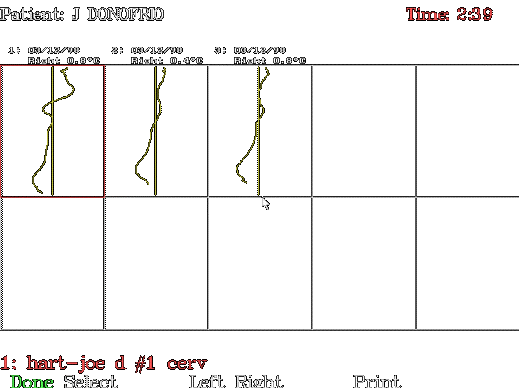Presented at the
16th Annual Upper Cervical Conference
November 20-21, 1999
Marietta, Georgia
TITLE: Thermographic Pattern Analysis using Objective Numeric Methods
AUTHORS: Edward F. Owens, Jr., MS, DC, Monte Penrod, BS, Torsten Stein, BS
AFFILIATION: Research Department, Sherman College of Straight Chiropractic, Spartanburg, SC
Analysis of paraspinal skin temperature patterns has been used in several chiropractic techniques as a method for detecting imbalances in the sympathetic nervous system that may be indicative of vertebral subluxation. The paraspinal skin temperature is often recorded with single or dual probe infrared, or thermocouple devices that provide a graph of temperature with respect to position along the spine. Interpretation of the temperature graphs varies with different techniques, but generally involves inspection of the graph by the doctor, looking for similarities in the pattern when compared to previous graphs, or deviations in symmetry of graphs. Patients are generally judged by the practitioner as being >in= or >out= of pattern based on this visual inspection. As this determination can sometimes be difficult, attempts are being made to develop a numeric method for comparison of skin temperature patterns. Such an objective comparison of skin temperature patterns will be critical in future studies of the stability of the measure, or changes that occur with chiropractic spinal adjustment.
METHODS
The TyTron C-3000 Paraspinal Thermal Imaging System [Titronics Research & Development Co., Oxford, Iowa] is being used to collect thermographic patterns on outpatients in the Sherman College health center. The TyTron is a hand-held dual probe non-contact infrared thermometer interfaced to a Windows-based PC computer. The TyTron is equipped with an encoded roller and photocell pickup that provides continuous information on distance along the spine as thermal scans are recorded digitally. The temperature patterns on the left and right sides of the spine can be displayed on the computer screen, along with a plot of side-to-side temperature differences. This difference graph is used most frequently in pattern analysis in the HIO or specific upper cervical toggle technique.
As the data from the TyTron is already in digital form, this instrument is particularly well suited to numerical testing for stability of patterns and waveform recognition. A search is underway for the best numerical method to apply in the assessment of thermographs. Stewart et al. suggested the use of a correlation method combined with a moving t-test (1). Correlation is very simple to calculate and has the advantage of also eliminating shifts that might occur in the patterns due to overall temperature differences that might accompany differences in room temperature, or patient acclimation. Owens used another simple method, first subtracting the average temperature of the scan from the patterns, then calculating the area between successive curves (2). Again, changes in pattern due to room conditions and patient acclimation are reduced in this method. A more sophisticated method, used in comparison of EMG signals, involves the use of the fast Fourier transform (FFT) to develop a series of coefficients that describe the frequency content of the patterns. This last method is attractive in that the coefficients can be stored for each thermal scan and then can be compared to any number of other scans without recalculation. The FFT is more complex however, since, while it provides information on frequency content in a sample, it does not indicate where in that sample particular peaks occur.
Current investigations center around choosing the best computational method, based on ease of use and comparability with pattern analysis as performed by practitioners. Since blinded evaluation of pattern congruence has been not shown to be highly reliable, a consensus determination can be used to create a comparison scale for the numeric method.
CONCLUSION
The need exists for an objective numerical method to compare paraspinal thermographic scans for similarity and stability over time. Such methods should offer increased objectivity in the determination of pattern congruence and will be critical in future studies of reliability and stability of clinical measures of skin temperature. Investigations are underway to identify the most applicable and least complicated computational method.
REFERENCES
Figure 1. A representative screen shot of the TyTron output.
